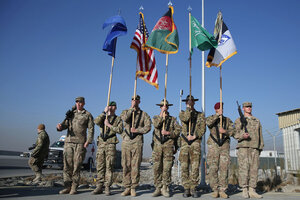Symbolic 'end' to Afghanistan war overshadowed by new Obama plans
The US and NATO closed their combat command in Afghanistan Monday, but US troops will remain and recent developments raise questions about their role.

International Security Assistance Forces take part in a ceremony in Kabul, Afghanistan, Monday that ceremonially ended their combat mission in Afghanistan.
Massoud Hossaini/AP
Washington
The United States military and NATO officially shuttered their combat command in Afghanistan in a little-noticed ceremony Monday, more than 13 years after the start of the longest war America has ever fought.
But what had long promised to be a major milestone in the war has been overshadowed by recent strategic changes on the ground. Even as troops lowered the flag of the International Security Assistance Force (ISAF) joint command – which was in charge of combat operations – Defense Secretary Chuck Hagel made it clear that the US will be jettisoning its original plan to cut forces to 9,800 by year’s end.
The Pentagon has announced that up to 1,000 more US troops than initially planned will stay in Afghanistan into 2015. In addition, recent reports have suggested that US forces will conduct “counterterrorism” operations rather than “combat” operations.
The moves “will not change our troops’ missions or the long-term timeline for our drawdown,” Secretary Hagel said in a news conference with Afghan President Ashraf Ghani in Afghanistan Saturday.
But they make the mission of US troops murky, many analysts say.
Originally, December was meant to mark the end of US combat operations in Afghanistan. After 2014, US forces had been slated to become trainers of Afghan troops, rather than fighters. Then came President Obama’s decision, reported last month, to allow US troops to continue to target Taliban fighters.
US officials insist that this is different from "combat" operations, and bristle at the notion that this is an expansion of the troops’ original post-2014 mission. US forces will now simply have a so-called “counterterrorism” mission alongside their training mission, they said.
This comes on the heels of a spate of recent Taliban attacks, though US officials insist that logistics, rather than an uptick in Taliban activity, is the reason for the extension of US troop deployments.
Still, US military officials have struggled to clarify what the "counterterrorism" mission will entail.
“While we won’t target Taliban for the sake – just merely for the sake – of the fact that they’re Taliban and quote unquote ‘belligerents,’ should members of the Taliban decide to threaten American troops or specifically target and threaten our Afghan partners in a tactical situation, we’re going to reserve the right to take action as needed,” said Rear Adm. John Kirby, Pentagon press secretary, in a briefing with reporters late last month.
It is unclear how the Pentagon will define “threatening” actions that will allow US troops to attack.
On Saturday, Hagel said Mr. Obama “has provided US military commanders the flexibility to manage any temporary shortfall we might experience for a few months as we allow for coalition troops to arrive in theater.”
It is clear that there will be a specific number of US troops designated as “counterterrorism” forces to go after terrorist targets in Afghanistan, but US officials have declined to say what percentage of troops, or how many US soldiers, this will include.
“I don’t know,” Kirby said. “I don’t have the breakdown for you on that. And I don’t know that it’s all that relevant to begin with.”

